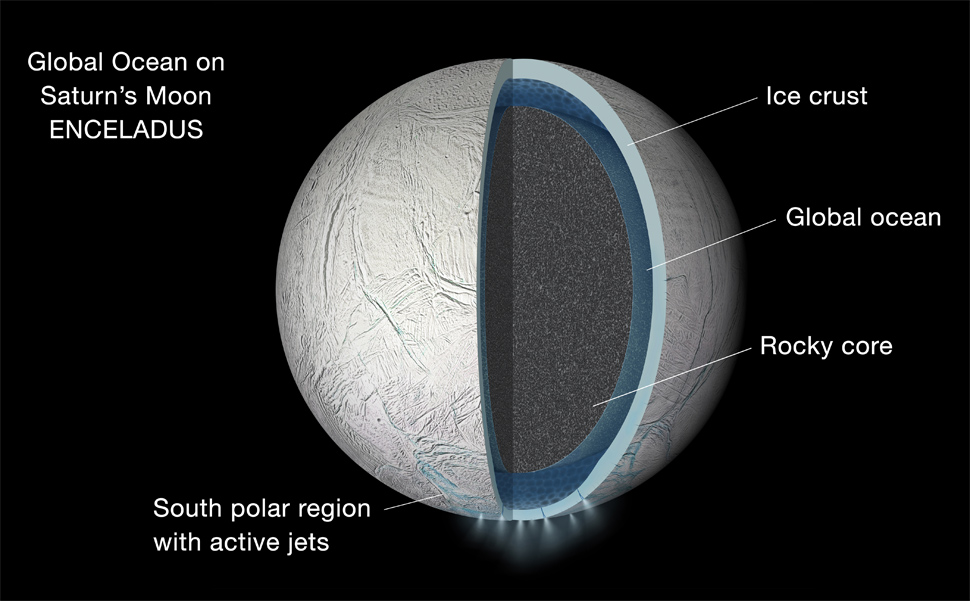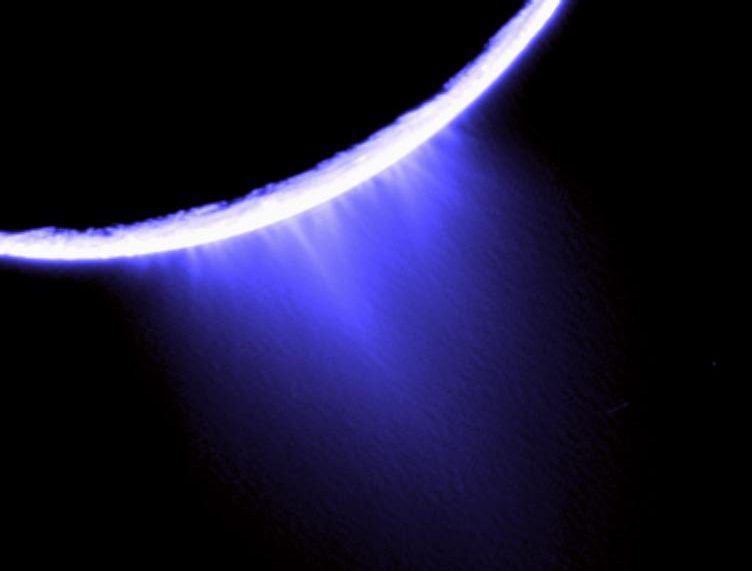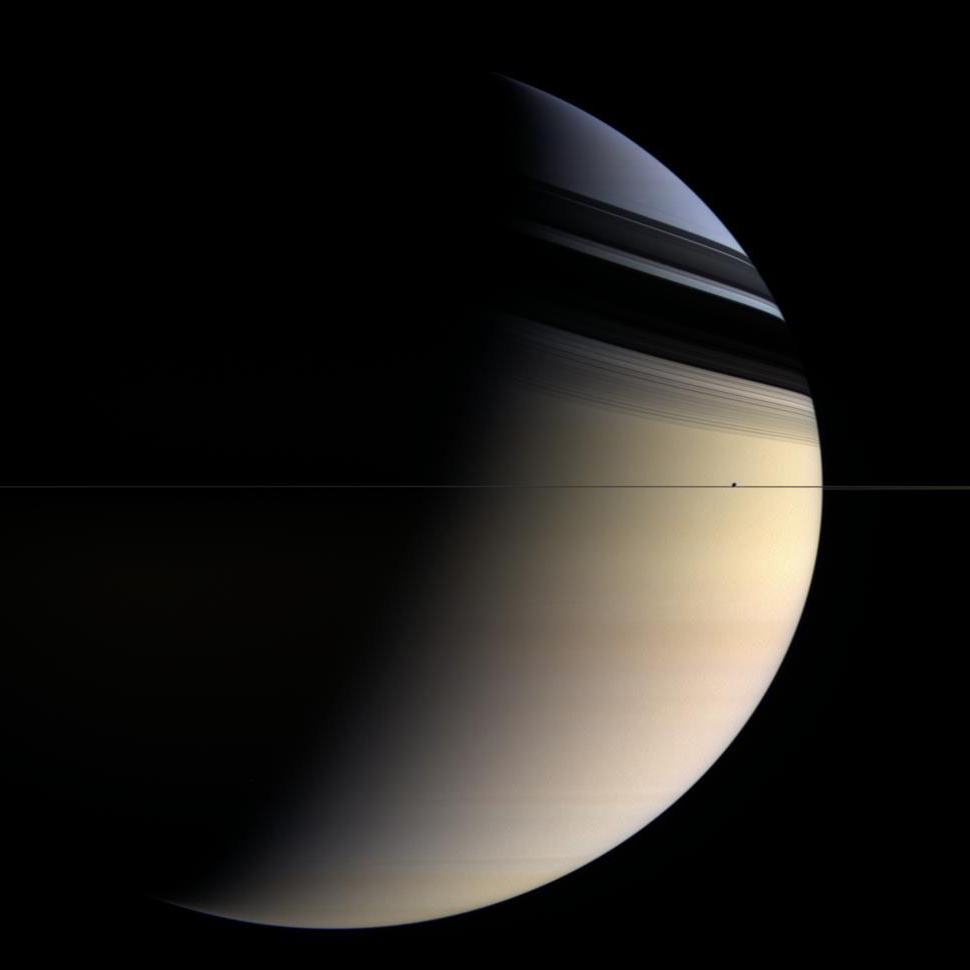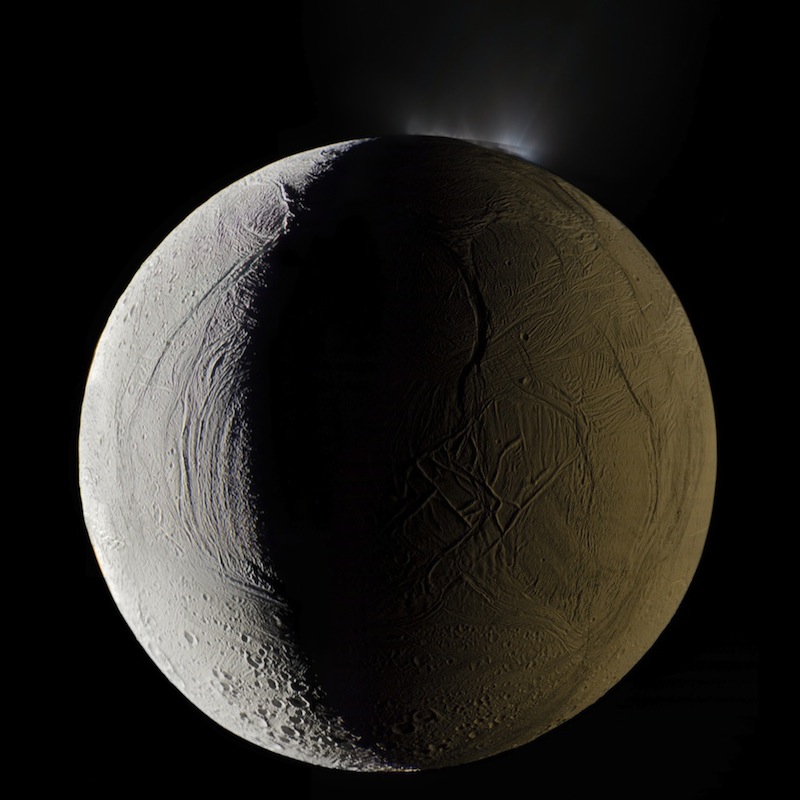
16th September 2015 NASA's Cassini probe finds global ocean in Saturn's moon Enceladus NASA's Cassini probe has discovered a global ocean lying beneath the icy crust of Saturn's geologically active moon Enceladus.
A global ocean lies beneath the icy crust of Saturn's geologically active moon Enceladus, according to new research using data from NASA's Cassini mission. Researchers found the magnitude of the moon's very slight wobble, as it orbits Saturn, can only be accounted for if its outer ice shell is not frozen solid to its interior, meaning a global ocean must be present. This finding implies that the fine spray of water vapour, icy particles and simple organic molecules observed coming from fractures near the moon's south pole is being fed by this vast liquid water reservoir. The research is presented in a paper published online in the journal Icarus. Previous analysis of Cassini data suggested the presence of a lens-shaped body of water, or sea, underlying the moon's south polar region. However, gravity data collected during the spacecraft's several close passes over the southern polar region lent support to the possibility the sea might be global. These new results – derived using an independent line of evidence based on Cassini's images – confirm this to be the case. "This was a hard problem that required years of observations, and calculations involving a diverse collection of disciplines, but we are confident we finally got it right," said Peter Thomas, a Cassini imaging team member at Cornell University, Ithaca, New York, and lead author of the paper. Cassini scientists analysed more than seven years' worth of images of Enceladus taken by the spacecraft, which has been orbiting the gas giant Saturn since mid-2004. They carefully mapped the positions of features on Enceladus – mostly craters – across hundreds of images, in order to measure changes in the moon's rotation with extreme precision.
As a result, they found Enceladus has a tiny, but measurable wobble as it orbits Saturn. Because the icy moon is not perfectly spherical – and because it goes slightly faster and slower during different portions of its orbit around Saturn – the giant planet subtly rocks Enceladus back and forth as it rotates. The team plugged their measurement of the wobble, called a "libration", into different models for how Enceladus might be arranged on the inside, including ones in which the moon was frozen from surface to core. "If the surface and core were rigidly connected, the core would provide so much dead weight the wobble would be far smaller than we observe it to be," said Matthew Tiscareno, a Cassini participating scientist at the SETI Institute, Mountain View, California, and a co-author of the paper. "This proves that there must be a global layer of liquid separating the surface from the core." The mechanisms that might have prevented Enceladus' ocean from freezing remain a mystery. Thomas and colleagues suggest ideas for future study that might help resolve the question, including the surprising possibility that tidal forces due to Saturn's gravity could be generating much more heat within the moon than previously thought.
"This is a major step beyond what we understood about this moon before, and it demonstrates the kind of deep-dive discoveries we can make with long-lived orbiter missions to other planets," said co-author Carolyn Porco, Cassini imaging team lead at the Space Science Institute, Colorado. "Cassini has been exemplary in this regard." The unfolding story of Enceladus has been one of the great triumphs of Cassini's long mission at Saturn. Scientists first detected signs of the moon's icy plume in early 2005, and followed up with a series of discoveries about the material gushing from warm fractures near its south pole. They announced strong evidence for a regional sea in 2014, and more recently, in 2015, they shared results that suggest hydrothermal activity is taking place on the ocean floor. Cassini is scheduled for a close flyby of Enceladus on 28th October, in the mission's deepest-ever dive through the moon's active plume of icy material. The probe will pass a mere 30 miles (49 km) above the moon's surface. The mission is expected to end in 2017, when the spacecraft is crashed into the upper atmosphere of Saturn. Future missions to Enceladus may include landers able to explore the surface and even drill into it. NASA is currently developing a massive new rocket known as the Space Launch System (SLS), including a 130-ton payload version due for operation in the 2030s. This rocket will greatly improve the capability of missions to the outer Solar System. In 2012, a NASA presentation – SLS Concept Of Operations (Con Ops) – outlined some possible long-term options for the SLS, including ambitious missions to the moons of Jupiter and Saturn: "The SLS [...] would have the payload capacity to provide shielding for a lander on [a moon's] surface, and sufficient fuel for propulsive maneuvers out of the gravitational well," the report said. "At Enceladus, a small active moon of Saturn, the SLS could carry the fuel needed to slow down for sample capture from the plumes on Enceladus, or create an artificial plume on either Europa or Enceladus by firing a copper projectile at the surface." Ultimately, robotic probes will be able to explore right the way down into the subsurface liquid oceans, though such missions are several decades away. In the more distant future, perhaps Enceladus will function as a resource extraction site for human colonists.
Comments »
|










